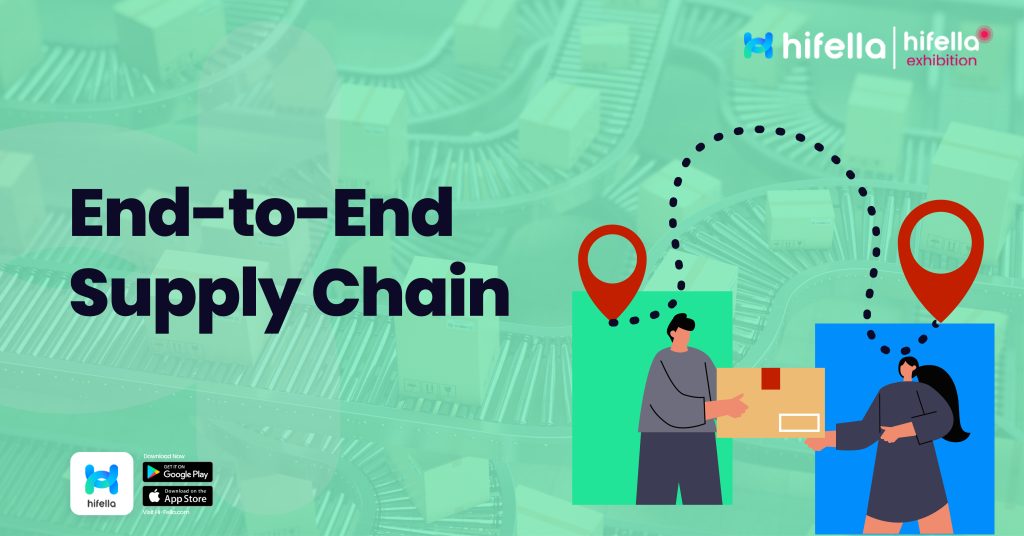When it comes to running a successful business, few things are as critical as an efficient and well-managed supply chain.
From sourcing raw materials to delivering finished products to customers, every stage of the supply chain plays a vital role in a company’s overall performance.
This guide dives into the concept of end-to-end supply chain management, breaking down its key components, explaining the benefits of a fully integrated approach, and offering best practices to help businesses optimize their processes.
Let’s explore how end-to-end supply chain management can transform your business from start to finish!
What is an End-to-End Supply Chain? Overview and Definition

Source: Cogoport
An end-to-end supply chain refers to the complete process of managing products from the initial stages of raw material procurement to the delivery of finished goods to the customer.
This integrated approach ensures that every step in the supply chain from sourcing, manufacturing, and logistics to distribution and customer service is interconnected and optimized for efficiency.
By managing the entire supply chain as one seamless process, companies can minimize bottlenecks, reduce costs, and improve customer satisfaction.
In today’s competitive landscape, an effective end-to-end supply chain is crucial for businesses looking to maintain a smooth operation, particularly those managing complex global logistics.
Key Components of an End-to-End Supply Chain
To understand how an end-to-end supply chain functions, it’s essential to break down its key components:
- Procurement and Sourcing
This is the initial stage where businesses acquire raw materials and components needed for production. Efficient procurement ensures that businesses can maintain consistent production flows and avoid costly delays.
- Production/Manufacturing
This phase includes turning raw materials into finished goods. Streamlined production processes are essential for meeting demand and maintaining product quality.
- Inventory Management
Effective inventory management helps businesses keep the right amount of stock on hand, ensuring that they can fulfill orders without overstocking or running into shortages.
- Logistics and Transportation
Moving goods from production facilities to warehouses, distribution centers, or directly to customers is a critical part of the supply chain. Optimizing logistics can save time and reduce transportation costs.
- Warehousing and Distribution
Efficient warehousing ensures that products are stored safely and can be quickly distributed to customers. Distribution processes are the final leg of the supply chain, delivering goods to customers accurately and on time.
- Customer Service and Feedback
A well-rounded supply chain doesn’t end with delivery; it extends to after-sales service, handling customer feedback, returns, and ensuring ongoing satisfaction.
Each of these components must work together seamlessly to maintain the efficiency of the entire supply chain.
Benefits of an Integrated Supply Chain Approach
An integrated end-to-end supply chain offers a range of benefits that can significantly enhance a company’s overall performance:
- Increased Efficiency
By integrating processes from procurement to delivery, businesses can minimize delays and streamline operations, resulting in faster production cycles and quicker response times to market demands.
- Cost Reduction
With better visibility and coordination, companies can reduce costs associated with excess inventory, inefficient logistics, and production delays.
- Improved Customer Satisfaction
A well-managed supply chain ensures that products are delivered on time, in good condition, and with proper customer support, leading to higher levels of customer satisfaction and retention.
- Better Risk Management
An integrated supply chain allows businesses to anticipate potential disruptions, such as supplier issues or transportation delays, and quickly mitigate risks before they impact operations.
- Improved Data Analytics
When every stage of the supply chain is connected, companies can collect valuable data across the entire process. This data can be analyzed to identify opportunities for further optimization and predict future demand trends.
Common Challenges in End-to-End Supply Chain Management
Despite its benefits, managing an end-to-end supply chain comes with its share of challenges:
- Global Trade Complexities
Learn about international regulations, tariffs, and customs can add layers of complexity to global supply chain management.
- Supply Chain Disruptions
Events like natural disasters, political instability, or pandemics can disrupt the flow of goods, causing delays and financial losses.
- Lack of Real-Time Visibility
Without integrated systems, it can be challenging to track goods in real-time, leading to inefficiencies in logistics and inventory management.
- Coordination Issues
Ensuring that all departments and external partners work together effectively is often a hurdle in supply chain management, especially for large organizations.
Best Practices for Optimizing Your End-to-End Supply Chain
Optimizing an end-to-end supply chain requires a mix of strategy, technology, and coordination. Here are some best practices that can help:
- Invest in Technology
Implementing supply chain management software and automation tools can provide real-time data visibility, helping businesses streamline operations and reduce human error.
- Increase Strong Supplier Relationships
Building and maintaining relationships with reliable suppliers ensures consistency in raw materials, reducing the likelihood of production delays.
- Continuous Monitoring and Improvement
Regularly evaluating supply chain performance allows businesses to identify inefficiencies and make data-driven decisions to improve processes.
- Improve Collaboration Across Departments
Encouraging communication and collaboration between procurement, production, logistics, and customer service teams helps eliminate silos and fosters an integrated approach.
- Embrace Sustainability
With growing pressure for environmental responsibility, incorporating sustainable practices such as reducing carbon emissions and waste can enhance a company’s reputation and efficiency.
Hi-Fella: Your Partner in Global Supply Chain Management

As businesses continue to expand their operations globally, managing an end-to-end supply chain can become increasingly complex.
Hi-Fella offers a comprehensive platform that supports companies in streamlining their global supply chains.
From connecting with international suppliers to navigating trade complexities, Hi-Fella provides tools and resources that enable businesses to manage their supply chains more effectively.
By joining Hi-Fella, companies can:
- Optimize procurement processes with access to global suppliers.
- Enhance visibility into logistics and transportation.
- Navigate international regulations with ease.
- Reduce costs and increase efficiency with integrated supply chain management.
Take control of your end-to-end supply chain today by joining Hi-Fella. Streamline your operations and connect with global suppliers. Sign up now and boost your supply chain management!








